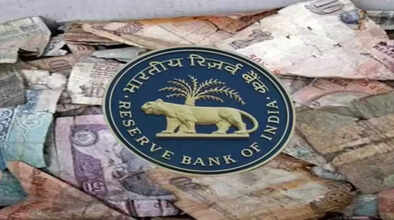What is the 'secret' of mutilated notes? What does the RBI do with these notes? You'll find the complete answer here without racking your brains.
RBI Rule: Have you ever wondered what the RBI does with old, mutilated, or torn notes? Find out how the Reserve Bank recycles thousands of tons of old notes every year instead of throwing them away or destroying them. So, find out what happens to your torn notes.

The Reserve Bank of India (RBI) manages the country's currency. Yes, every note enters the market under the RBI's supervision. While everyone keeps crisp notes in their pockets, what happens to old and torn notes? Every year, millions of old and damaged notes, torn, dirty, or burnt, arrive. The RBI disposes of them properly to ensure they don't have any negative impact on the country's economy. But the question remains: what happens to old notes? So, let's learn, in simple terms, what the RBI does with old and damaged notes, the process, the legal regulations, the benefits, and the precautions.
The Role of the RBI
The RBI is India's central bank. It prints and distributes all circulating notes, and also ensures the proper disposal of old notes. This responsibility is under the RBI Act of 1934. Yes, in 2025, there are approximately 9.6 trillion notes in circulation. Every year, 20-25% of these notes become damaged, and the RBI destroys them and issues new notes.
Now, let's understand the process for old notes.
1. Deposit at a Bank Branch
If you have old notes, deposit them at a bank branch. The banks then send them to the RBI. There is no limit, but submit them in bundles of 500 notes.
2. RBI Collection Center
The RBI's 19 issue offices and collection centers check for torn old notes. Machines sort the notes, returning the good notes to circulation, while the bad ones are completely destroyed.
3. Inspecting Bad Notes
Notes are inspected before destruction. Basically, bad notes are those that are less than 50% intact or torn. RBI regulations state that if more than 50% intact, they are considered valid. By 2025, approximately 1.2 lakh tons of notes were destroyed.
4. Understand the Destruction Process
Defective notes are shredded using a shredder machine. They are then burned in an incinerator. The ashes are then disposed of in a landfill. This is done at the RBI's central office and branches, and environmental regulations are followed.
Legal Rules
Note Destruction: The most important thing to know is that under the RBI Act, only the RBI can destroy notes.
Validity: Even damaged notes are valid, but they can be exchanged with the RBI.
Destruction of private notes: Never burn notes privately, as this is considered a criminal offense.
Benefits
Clean currency: Removing old notes will bring new notes into circulation.
Strengthening the economy: This will make it easier to prevent counterfeit notes.
Environment: Paper will be easily recycled.
Precautions
Always exchange damaged notes at the RBI or a bank in a timely manner.
Notes in your possession should be kept clean.
Always check for counterfeit notes.
How the RBI will use the notes
The Reserve Bank of India (RBI) is now considering using old, mutilated, or out-of-circulation notes to make furniture and other useful items. This will reduce waste and benefit the environment. This initiative to reuse old notes could be considered a good step from both economic and social perspectives, although it has not yet been officially approved.
Conclusion
You should now understand, simply put, that the RBI disposes of old and damaged notes by sorting, checking, and burning them. Yes, this is part of currency management, so notes should be treated with care. (This information is taken from the RBI's annual report.)
5 FAQs
Q1 - What does the RBI do with mutilated notes?
The RBI is planning to recycle old and mutilated notes instead of destroying them, using them to make things like furniture.
Q2 - How many old notes are collected each year?
The RBI collects approximately 15,000 tons of old and mutilated notes each year.
Q3 - How did the RBI previously dispose of these notes?
Previously, they were burned or buried, which harmed the environment.
Q4 - What will the RBI do with these notes now?
The RBI is working to recycle these notes into useful products like furniture and boards.
Q5-Is this process environmentally friendly?
Yes, recycling notes is environmentally friendly and will improve waste management.

